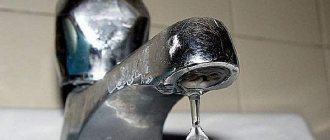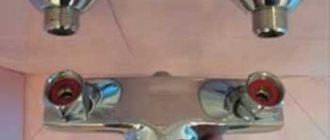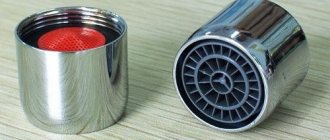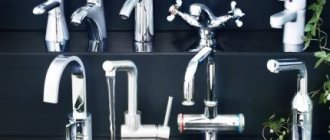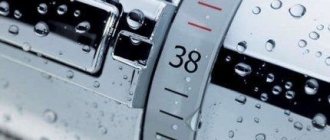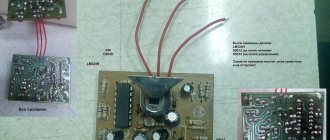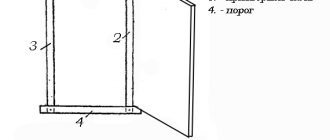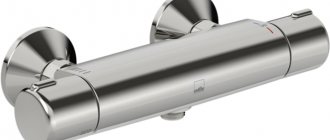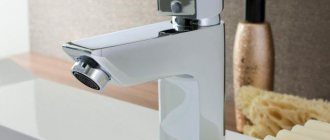Most of us have a single-lever cartridge faucet installed in our kitchens and bathrooms. The cartridge is the main part of the faucet, which is responsible for opening, closing, turning the spout, closing types, the degree of jet intensity, etc. Therefore, as soon as any problems appear in its operation, the mixer cartridge needs to be repaired. The cartridge acts as a shut-off valve, however, this part may leak or fail for another reason. Then it will have to be changed.
How to choose a cartridge for a faucet - types, manufacturers and tips
Any specialist will tell you that the surest way not to make a mistake when choosing a cartridge for a faucet is to remove the faulty product and go to the store with it. You should purchase the same thing - “one for one”. The fact is that quite often there are mixers on sale, the design features of which require the use of only one, “own” cartridge. How to act in various situations, what to pay attention to - you can learn about this from this article.
Features of different cartridge models
The fundamental difference is in execution. Cartridges can be ceramic (with plates) or ball. But there are some nuances that distinguish one from the other. The main parameters may be the same, but the manufacturer is different.
If a given plumbing part fails, independent repair (even if it is of a collapsible type) is not carried out - only replacement. So which faucet cartridge is still better to choose?
Knowing some features of trademarks will make this task somewhat easier:
Useful tips
When dismantling a faulty cartridge, you do not need to make significant efforts, as there is a risk of breaking its plastic case. If it is “stuck”, it is enough to treat the grooves with “liquid wrench” (WD-40), and after 5 – 10 minutes the part will be easily removed from the socket.
When purchasing a faucet, it is advisable to purchase a spare cartridge. It is inexpensive - from 23 to 40 rubles, depending on the type. But household members will not have to sit without water while the owner looks at retail outlets for what is needed to fix the problem. The procedure is simple - remove the failed sample, install a new one, and with a broken product - go shopping, look for exactly the same one.
If for some reason the old cartridge is missing (for example, lost), then you can take measurements at the location where it is installed on the mixer. What needs to be determined:
To avoid frequent repairs, you should not purchase parts from an unknown manufacturer. It is better to pay more and buy a product from a well-known, well-established brand. Such expenses are completely justified, especially since we are talking about relatively small amounts.
On a note! If there are problems with the faucet, then first of all you should look for a faulty part from the same manufacturer as the plumbing fixture itself!
Source
How to change the cartridge of a lever water mixer with your own hands
Water faucet cartridge
- this is an element of shut-off valves that provides manual control of the supply and mixing of cold and hot water in the mixer.
The structure of a lever-type mixer is shown in the photograph. The base of the mixer is a glass made of brass. Cold and hot water are supplied from the bottom of the glass through separate tubes; a spout is soldered to the side, through which water flows through the aerator into the sink or bathtub.
A ceramic cartridge is inserted into the glass from above, thanks to which you can use a lever to control the flow of water and regulate its temperature. To secure the cartridge in the mixer in the desired position, use a clamping nut, and to hide it, a decorative washer.
When the lever is lowered, the water is shut off; when it is lifted up, water begins to flow into the spout. To control the water temperature, the mixer lever must be turned to the right or left. When the water pressure in the water supply is low, lever-type faucets are very convenient, as they allow you to open and stop the water supply almost without touching the lever.
Thanks to the use of ceramic plates instead of rubber to control the flow of water, lever-type faucets have a long service life. But nothing lasts forever, and over time, the ceramic plates wear out and water begins to seep between them.
Due to the simplicity of their design, ceramic lever-type faucets can be easily repaired with your own hands; just replace the cartridge according to the suggested instructions.
Problems during operation
Even high-quality plumbing fixtures fail over time. The service life of the faucet depends on the material from which it is made, the quality of the tap water and the intensity of use. The most common problems that arise when using single-lever models are:
- Cracks on the device body. They arise due to poor quality material and installation errors.
- Aerator clogged. The cause of this malfunction is the poor quality of tap water.
- Wear of rubber gaskets. Seals are consumables; they wear out over time due to the high intensity of use of the device.
Important! No matter how high the quality of the faucet, it needs preventive maintenance. Even if no problems arise during operation, you need to disassemble the device once every 2 years, clean it, and replace the gaskets. After all, even a small speck that gets under the seal can cause a leak.
Replacing the cartridge in the mixer
Determining the cartridge size
Before replacing the cartridge, you need to decide on its design and dimensions. The height and mounting dimensions of the lever are usually the same.
The photo shows the four most common types of cartridges. The cartridge in the second position is designed to control the supply of cold or hot water only. Most kitchen and bath faucets use the last two types of cartridges.
Cartridges are mainly used in two sizes – ∅35 mm and ∅40 mm. The size of the cartridge can be determined by eye, but it is more reliable to measure with a ruler.
To choose a suitable cartridge for repair with a guarantee, it is advisable to remove it from the mixer and go to a plumbing supply store with a sample. But in this case, you will have to shut off the supply of both cold and hot water, thereby leaving the apartment without water supply.
You can find out the cartridge size without removing it. To do this, it is enough to remove only the lever with the decorative ring and measure the dimensions of the rod (usually its size is 9 mm by 9 mm) and the outer diameter of the fixing nut.
Common troubles
The single-lever faucet design has only three common problems.
| Malfunction | Circumstance |
| Handle jamming, enormous hardening during adjustment | Lubricant washout (in most cases occurs after 5-8 years of operation) |
| Broken rod (the handle is completely separated from the body) | Excessive hardening applied to the handle |
| Inability to shut off water, leaking when the handle is in the lower position | Chips of plates due to debris, breakage of plastic clips due to excessive hardening on the lever |
Let's highlight: the single-lever mixer closes, opens and is adjusted with smooth movement, without unnecessary hardening. The cause of most malfunctions is the habit of turning off the water with a sharp blow to the lever.
Sticking of the handle can be eliminated by re-lubricating the rubbing plates. A special lubricant for the mixer cartridge and ceramic axle boxes is sold in branded plumbing stores; the price of a small tube is 400 - 600 rubles. A more affordable option is silicone lubricants used for household purposes: a 30-gram tube will cost only 120 - 140 rubles.
In all other cases, the repair instructions boil down to replacing the cartridge completely.
Replacing the cartridge in the faucet in the kitchen and bathroom
Changing the cartridge in a shower, bathtub or kitchen faucet yourself is not difficult. The whole process takes up to 30 minutes even for a beginner.
Let's look at how to replace a cartridge in a faucet with your own hands using the example of a Damixa single-lever shower faucet (this is almost a complete analogue of Grohe):
Removing the decorative faucet plug using a screwdriver
This is what the hole under the decorative cap looks like
Removing the clamping nut in the mixer
The replacement cartridge must fully match the dimensions and materials of the part that is being changed. First of all, attention is paid to its shape and the location of the holes for the rod. For Blanco TALOS-S and Hansgrohe faucets, the shut-off devices may differ even depending on the faucet model.
Kitchen faucet Blanco TALOS-S
Please note that some cartridge models are universal, but most can only be used in certain faucets. Therefore, if you need to change the cartridge, it is better to choose a model of exactly the same brand as it was (Aqualux, Vidima, Oras or Esko).
How to remove a cartridge
After the handle is unscrewed, you can remove the cartridge from the mixer with a slight movement of your hand upward and to the side. Another question is if the mixer lever cannot be removed for some reason.
Sectional demonstration of cartridge removal
To remove a stuck handle on a kitchen or bathroom faucet (using the Vidima model as an example), you need to:
Sticky handle in section
Installing a cartridge in a faucet
The cartridge is installed in the reverse order of disassembly. Step-by-step instructions on how to assemble the mixer:
Installing a cartridge in a faucet
Screw the screw back in
Installation of a decorative die
Popular cartridge sizes
Naturally, the cartridge sizes are standardized for each mixer model. For washbasins, sinks and showers, the most common sizes are 28mm, 35mm and 32mm. At the same time, parts from 40 mm to 46 mm are most often used for the bathroom (in particular, in Grohe and Kaiser). But why is there such a difference in almost identical mixers?
It is believed that the larger the ceramic mixer for a single-lever faucet, the better it is. In fairness, it is worth noting that with Chinese taps (with the exception of FRAP), where the diameter of the spout is often larger than that of branded ones, this rule is actually followed. But for branded models (Fiore Rubinetterie, Iddis, Sedal and others), a large cartridge is not always synonymous with quality.
Technical characteristics (diameters) of different mixer cartridges
Let's look at the technical characteristics using the example of a cartridge with a Touch-Z brass rod:
Similarly, based on the characteristics, you can choose a cartridge for a kitchen faucet. Let's take Potato as an example. The diameter of the swivel spout is important here - it is recommended to use sizes from 26 mm to 30 mm. To supply hoses, a hole from 38 mm to 40 is used, depending on the model.
The listed sizes are considered standard, but for many original faucets they are not suitable due to their too large diameter. In such cases, non-standard components for 18 mm, 20 mm and 22 mm are used. Hose connections can also be made in holes from 25 mm to 26 mm or more.
Bonus
With legs
There is another type of cartridges - the so-called. "with legs."
Remove the bottom
The device is the same as a regular one, only the plastic bottom is different: the water comes out of it not just into the hole at the bottom, but into a large chamber:
This design is slightly larger in size, but allows you to choose a place for water outlet along the entire bottom or in the lower part of the wall surrounding the cartridge. Compare faucet bodies for a regular cartridge (left) and a two-legged one (right):
Diameters
Cartridges come in different diameters; in Russia, 35 and 40 mm are the most common. Theoretically, the larger the diameter, the greater the throughput, and therefore the flow rate (although the difference of 5 mm, after all, is not so significant).
Through hole in plate
It happens that the hole in the ceramic plate is not blind, but through and is plugged from above with a plastic plate with an elastic band. This bipedal cartridge has just such a case.
Yes, pay attention to the plastic pins , they act as a noise suppressor .
Dovetail Ledge
Some cartridges have a dovetail on the inside of the body that fits into a slot in the driver (pictured: KCG cartridge).
The leash is located above the outlet. Due to this additional limiter, when the “hot/cold water” ratio changes, the driver rotates not around the axis of the cartridge, but around the axis of the outlet hole. It turns out that the plates move like windshield wipers on a car.
Ball cartridges
At one time, some manufacturers tried to make truly spherical cartridges with a main assembly made of a stainless steel ball, but now they have mainly switched to cartridges with ceramic plates, which work on approximately the same principle.
Types of cartridges for faucets
Cartridges are classified according to their design and operating principle. There are the following types of devices:
This is what ball cartridges look like
Operating principle of a disk cartridge
According to the material used they are:
Ceramic cartridge for GROHE faucet
According to the principle of operation, as stated above, cartridges are divided into two types:
Typical cartridge of single lever faucets
Shower faucet cartridges
Each type has its own design features. For example, the number of holes for pipes and the shape of the linings for installation in the grooves.
Ceramic faucet cartridge
The design of a ceramic faucet cartridge is a simple design, where the main parts are two plates. They fit tightly to each other, due to which the pressure and temperature of the water are controlled.
Ceramic faucet cartridge
Some of the most famous models are Hansgrohe and Grohe. Can be used for kitchen sinks, bathroom sinks and showers. This locking device requires regular lubrication due to the constant friction of the ceramic plates. If there is a leak, it cannot be repaired; if it breaks, it will need to be replaced.
Cartridge for shower faucet
The cartridge for a shower faucet is also called a diverter. It is designed not only for 3 water mixing positions, like standard parts, but for 4 positions or more. The quantity depends on the connected devices (for example, if a hydrobox is used, the diverter operates in 5 positions).
Shower faucet cartridge
To switch positions, a brass rod with plates is used, which rotates 360 degrees around its axis. This angle allows you to combine several mixing modes - up to 6 lever positions.
Cartridge for single lever faucet
The cartridge for a single-lever mixer (GOST 25809-96) or a one-handed faucet is the most common locking device. Its operation is ensured by a lever that can rotate in different directions to change the position of the cartridge locking device. It comes in ball and disk types.
Single lever faucet cartridge
It used to be used exclusively in bathroom sinks, but is now also used for kitchen plumbing outlets and shower stalls.
Cartridge for ball mixer
The cartridge for a ball mixer is a fairly simple design, where at the bottom of the device there are several holes of different diameters. There can be 2 identical ones and 3, where one of them is larger.
The water is mixed here by changing the position of the stop ball. It can close all the holes at the same time or only half of them, changing the water pressure.
Thermostatic cartridge for faucet
The thermostatic cartridge is used for faucets equipped with a thermostat. On one side of such a faucet there is a special temperature scale where you can select the desired parameters. The thermostatic lock is constantly in a given position, maintaining temperature and pressure at a certain level.
Cartridge for thermostatic mixer
This device is often used in public places, such as washbasins or bidets.
What does such a device affect?
The main task of the cartridge is to provide the necessary pressure and temperature of water when mixing hot and cold flow. Manufacturers more often use ceramic disk parts for the reason that they are easier to manufacture and maintain.
Expert opinion
Smirnova Ekaterina Anatolevna
7 years of experience in interior design, professional architect
These products have no advantages over ball types. While the parts are identical in terms of workmanship and service life, there are significant differences in maintenance and repair.
Mixer cartridge repair
You can do cosmetic repairs to the faucet cartridge yourself. But, we immediately note that this only applies to breakdowns associated with clogging of the working surfaces or wear of the thrust rings. If the plates or balls are worn out, cracks appear, etc., then the device must be replaced. It will not be possible to repair it either professionally or independently.
Collapsible cartridge design
What can be done when redecorating a single-lever mixer:
Adjusting the thermostatic cartridge
Video: disassembling the cartridge of a single-lever mixer https://www.youtube.com/watch?v=5PkkfSig46I
Basic faults
If the faucet leaks when it is turned off, this is a sure sign of a cartridge failure. The consequences of a malfunction can be anything, from flooding neighbors to astronomical utility bills.
If the faucet drips, it leaks from the spout in the closed position, or water leaks from the spout when switching to the “Rain” mode (in the shower), then you need to disassemble the faucet and replace the cartridge. The main reason for water leakage may be that the locking mechanism is worn out or the cartridge itself is cracked.
Dripping from the aerator due to a faulty mixer (photo is for illustrative purposes only)
Likewise, if a flag or two-valve faucet hums, creaks or turns hard. There could also be several reasons:
Basic faults
During the operation of the mixer, malfunctions arise that are associated both with the quality of the water and with incorrect operational features of the plumbing fixture. The axle crane takes on a large load, since water under high pressure passes through it.
If the spare part is of low quality, then after several months of active use the mixer will leak.
Frequent causes of faucet cartridge failure:
- hard water with a high content of salts and mineral scale, which accumulates on the core of the mixer, the cartridge simply “sticks” and becomes coated with plaque;
- pressure differences in water supply. With sudden jumps, the part quickly breaks and bursts;
- If the diameter of the faucet spout does not correspond to the size of the cartridge, then noise and crackling will be heard when water is supplied.
- Lubricate the plates. This will help reduce friction and increase operation. Oily mixtures and sealants are used.
- Adjust the thermostatic cartridge if the device has reset due to frequent use of low-quality water.
- Remove clogs from the threads using an old toothbrush.
How to choose a faucet cartridge
To choose the right cartridge for the faucet, you need to pay attention to the main characteristics of the device. This:
Chinese cartridge with plastic stem
Grooves in the cartridge and mixer
Naturally, it is better to buy high-quality models from European manufacturers. Good reviews about Grohe, Kaiser and Blanco. But, if necessary, you can choose good Chinese options. These are Potato, Frap and others.
Source
